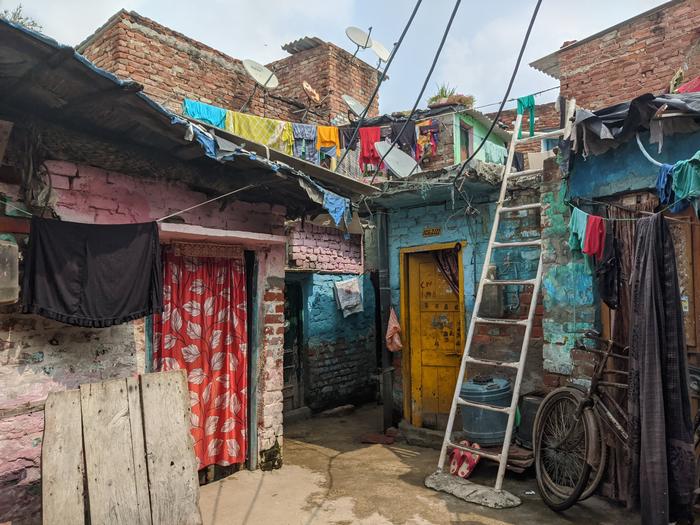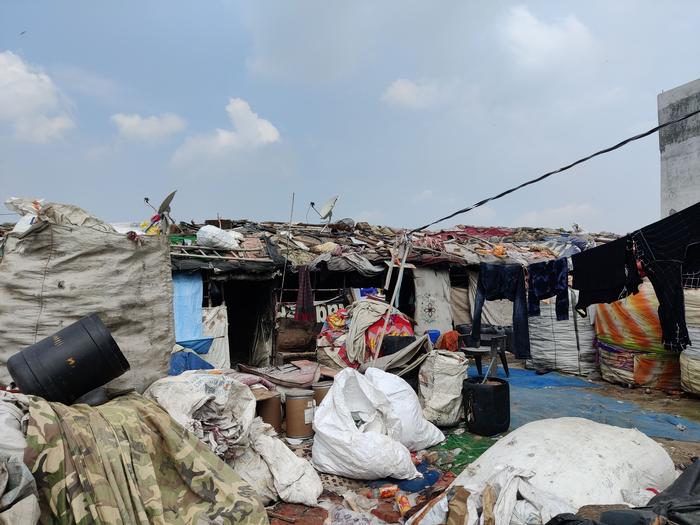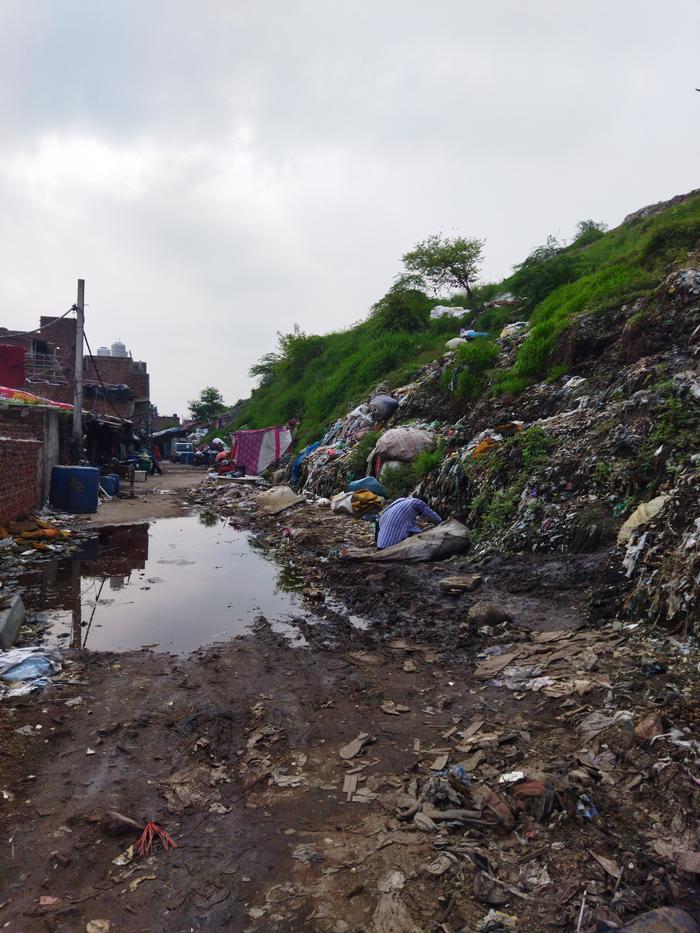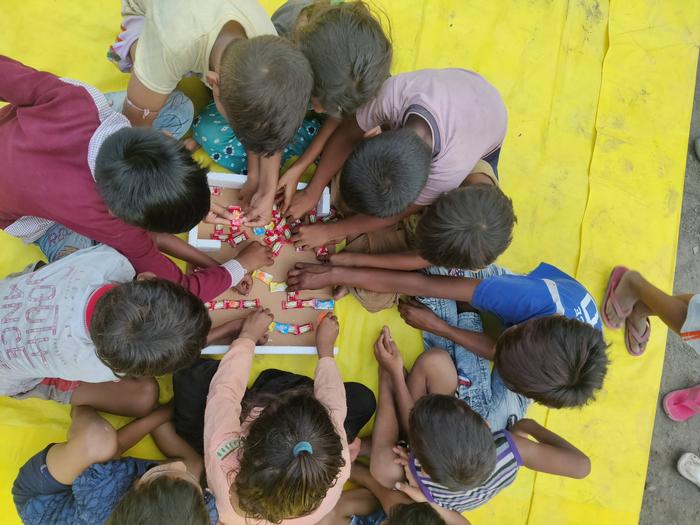[ID:4669] A Place Called HomeIndia Who are you?
“My name is Pinky. I live in Kalandar Colony”, says the 10-year-old.
“I help my mother get water and clean all day and go to play in the evening. I want to go to school again, but who will do all this if I go?” sombre, she continues.
She quickly gets to helping her mother. Her task today, much like every other day, is to heave all their drums and buckets and fetch days’ worth of water from the provisional municipal tanker. For a little girl, only ten years old, moving the heavy water barrels is a mammoth task. As she struggles to bring water home, she vividly recalls powerful men in white kurtas and their promises for a supply line. What’s taking them so long?
Last year, in a fit of rebellion, she’d tried an easier route: fetching water from the old hand pump behind her house. Little did she know that this would make her baba sick for weeks to come. “Water is an odourless and colourless substance,” she recalls reading in her textbooks. Why then, was this water brown?
Pinky is not alone in her struggles. In the north of India’s capital of New Delhi, is the neglected town of Bhalswa. A mountain of a dumpsite flattens the surrounding landscape, concealing the fact that the region is, in fact, not uninhabited. Today, over 200,000 people live, and continue to bear the worst living conditions in the city. Despite playing a crucial role in the city’s waste management and recycling, they continue to exist silently in the margins. Concerns relating to water and sanitation are only a few of the many challenges that these communities bear in their day to day existence.
With over half of the city’s waste being indiscriminately dumped in the area for four decades, the landscape surrounding Bhalswa has turned degenerate. With all - water, air, and earth contaminated beyond measure, affected communities live with little dignity. The frugally built structures at the edge of the dumpsite lack basic facilities in and outside the home, and make daily life a big challenge. Cramped spaces with the lack of proper light and ventilation is a breeding ground for health problems, both mental and physical. Without any proper spaces to work, play or go about their daily routines, people configure streets as a poor consolation. Walking through the galis at Bhalswa, one can easily see drains overflowing with human and animal effluents; with children playing, or even eating right next to them, countless flies buzzing around. Why are we so desensitised to horrific scenes like this?
Along with its hazards, the dumpsite also comes with a stigma that these communities are associated with. Shunned by the city for their very living conditions, the people feel compelled to continue on with their lives. A stark dichotomy exists everywhere: there lies a 36-hectare golf course barely a kilometre from Bhalswa! Why is it then, that people have to live in such an unhealthy, unhappy and undignified environment?
The Bhalswa dumpsite is currently going through a state-sanctioned remediation process. However, there is no plan for the communities around. This only makes one wonder: does rehabilitation follow remediation? What is to become of the thousands of people that inhabit Bhalswa? Where will they go?
Existing Answers
With its ever-growing urban population, social housing in India is merely a matter of numbers. The metrics for progress are seen to be the mass of constructed housing stock, which still are not enough. Going beyond, one finds that these mass-produced units lack any semblance of the people they intend to house. They lack sensitivity in spaces, facilities, locale, and even expression! People from marginalised communities like Bhalswa are expected to mould their lives and livelihoods around these projects. Unsurprisingly, these buildings often lie unoccupied or soon turn into slum-like conditions themselves. Is it not essential for these communities to practice agency over their own living?
Rethinking Practices
“If the question is to cross a river, why should the answer always be a boat?”
I believe that housing is a conversation. In India, social housing is limited to internal communication between housing boards and builders. This turns it into a civic commodity: a race to achieve metrics that look good on big billboards and banners.
In 2020, I co-founded a grassroots initiative called Better Bhalswa. Two years of participatory planning for place-based solutions via community engagement have taught me how substantial a role housing plays in society. The persistent problem does reflect bad architecture but needs a system-driven approach. Good design cannot do wonders in the absence of good policy and ecosystem. All my time spent on-ground has made me rethink my role and my perspective as an architect and designer. To start, why don’t we, as architects of tomorrow, understand people who can play a relevant role in creating a place another can call home?
Where do you live?
“I am Rita. I live in Kalandar Colony. All the houses here are small and very dark, with no open areas. I wish I could have a balcony in my house, I would get so many plants! The plants would also need some water, right?”
Housing can reform the way people live and improve their quality of life. Rita’s aspiration for a simple balcony tells us that housing is also inherently tied to peoples’ identities and dreams as well. How can we make sure we make public housing people-centric? Through my time working at Bhalswa, I have realised that long-term community engagement, that goes beyond a couple of surveys, can help mould spaces that fit people the best.
Who could help you?
“I sit all day next to the toilet to make sure it stays clean, but there are just are too many people using it! This place is so secluded and dark at night, I fear for the women who have to use the toilet after sundown,” explains Rani. She is a caretaker for the municipal toilet, who constantly reaches out to the authorities for health and sanitation issues.
“We cannot take on solving all issues by ourselves. We need the authorities to listen to us and work with us. However, any effort we make falls into deaf ears,” emphasises Manoj, a community leader.
Self-organisation in marginalised communities is rarely seen. Despite having a few isolated leaders, solving even trivial problems is full of conflict. Enabling community leadership can induce a sense of unity, responsibility and support amongst the community to work together to build better homes for themselves.
Who will facilitate and regulate processes towards better living conditions?
“As ministers, we want to contribute to development, so we willl look into this,” says a nameless mantri .. It comes as no surprise that this never gets looked into.
Institutional lethargy is probably the biggest reason that social housing in India is in a state of dismay. This apathy has led to a lack of assertiveness amongst people themselves, wherein they’ve stopped demanding change. They’ve gotten accustomed to bad lifestyles, and lack self-organisation and resolve.
There is also a certain lack of awareness about government schemes and policies, added with cumbersome paperwork and legal conditions. This makes even any small opportunity very inaccessible for marginalised communities. A centralised framework for the entire country further contributes to the homogeneity we see in projects today.
Communities and individuals could be excited about bringing in a housing revolution, but institutions are necessary for policy regulations and frameworks. I believe that a degree of flexibility and understanding can encourage collaborative practises with the community at the centre of the discourse. Today, the State acts as an absolute Provider without establishing any on-ground relationships. Imagining the State as an Enabler rather opens up a lot of opportunity for cohesion and collaboration.
Who will bring in the necessary funds for social housing?
“Why not get the government to give us low-interest loans if we form a cooperative body of our own?”
A lot of 'alternative' housing projects all across the world have adopted self-financing models. These work with government and/or private aid as low-interest or micro-credit, or cross-subsidization and land-pooling schemes. Could something like a CSR scheme work towards public housing?
Models like the Assemble and Nightingale even depend on investors for funding their projects. However, the rules around these investments make them low profit and hence, non-speculative. These houses are then directly given to the community. The Baugruppe Model allows people to self-fund and lead their projects, with the help of professionals like architects. Zurich also has a strong culture of cooperatives where members hold shares of the project for a secure rent.
These are only a few models, and they differ in stakeholders, function and governance. Nonetheless, they prove that such models can be successful when developed around local needs and conditions. Financial experts have a role to play here, as advisors to the project team to generate suitable plans for the particular project.
Who are the external agencies that can monitor the process and fill in gaps between the community and authorities/ funders?
“Navigating through several challenges, and delegating with numerous authorities, we work to create inclusive public spaces with the community. In the process, endowing them with new skills, and building capacity.” says Gunraagh Singh Talwar, a young architect, social innovator and co-founder of Better Bhalswa.
In 1984, a few women from pavement settlements in a neighbourhood in Mumbai, met to discuss their problems and possible solutions. This went on to become the Mahila Milan (women’s group), who started to teach women finance and saving. Today, Mahila Milan works with the Society for the Promotion of Area Resource Centres (SPARC) and the National Slum Dwellers Association (NSDF). They provide quality housing and infrastructure to the urban poor in several cities. They work with the community, authorities and private sector to develop innovative solutions. All these stakeholders work in direct collaboration, be it funding, design, procurement or construction. They engage in awareness and capacity building of the community, and then hire skills from the community itself to build their homes. This leads to not only a sensitive housing project, but also lifelong skills like financing, saving, collaborating and leadership for the community.
Non-profits have both community roots and the resources to negotiate with authorities. Over the past year, I have learnt how they can play a vital role in organising communities for more impactful communication and process. They can also play a great part in bridging gaps. That, of course, comes with barrier-free and smooth bureaucratic processes.
How can we ensure quality spaces and structures?
“We need to create specific links to specific organisations working in different fields. This can make the collaborative process more efficient," says Shreyank Khemalapure, an advocate for better public housing.
The early-on involvement of technical professionals like architects, ecologists, engineers, financial experts and lawyers can greatly help in technical aspects. This includes developing financing models, working with low-cost materials and construction technologies, designing spaces that adapt to different family sizes, structures, livelihoods, and lifestyles, or crafting lively outdoors for people of all ages.
How will we make the construction transparent and efficient?
“As a local contractor, I can hire from the community and keep the construction process efficient.”
The current public housing model involves development institutions tendering out construction to government, or private contractors. This is a tedious process that can take months and years, and doesn’t make the contractors answerable for the quality of work they provide. Even with community engagement and a democratic process so far, handing over the project to a developer only drives monopoly and reduce accountability.
A Building Group is a group of people who come together to make their own housing model as per community will. This cuts down on developer costs, and these people can get their houses built for a much lesser cost. They hire local contractors, ensuring transparency in process, reduced costs, and answerability. Kalandar Colony, like most slums, has built its dwellings on its own, without any external support or aid. This skill of self-building, with more education and guidance, can not only generate skilled workers from the community itself, but also aid in capacity building. The Uruguayan cooperative housing model uses this as ‘sweat equity’. People who cannot afford to pay for their housing in money, pay with their time and labour.
I believe that the process of housing doesn’t end with construction and possession, which is why it is important for collaboration post-occupancy as well. This gives a chance to take lessons and to fix problems that still persist.
A question for you
There are millions of people like Pinky, all over the world. In this race of generating profits from everything, we’ve gotten desensitised to people on the margins. Land and resources, when seen as a commodity, lose their meaning as enablers of quality life.
Housing is an ecosystem of social instruments, rather than being an isolated object. It starts the opportunity to create institutions for education, health, etc. and create livable habitats. It lies at a pivotal intersection of the physiological, social and financial aspirations of every individual, but only a few get to have agency over it.
"Alone we can do so little; together we can do so much." - Hellen Keller.
I believe that the future lies bright in conversations and collaborative ecosystems, and housing is only one, to begin with. How do we go into a community and use its strengths, while bridging the weaknesses?
The Nightingale, Assemble, SPARC and others are only a few initiatives amongst many more that have helped me with my own, Better Bhalswa. They show that change comes with radical conversation and action. If we want Pinky, Rita, Rani, Manoj and others like them to live a healthy, happy and dignified life, now is the time to take collective action.
Why do we remain apathetic towards human distress? How could people get more agency on the houses they live in, the land they inhabit, and the cities they reside in? How could a city help a community that has been contributing to the city from the margins for decades? How can we build strong ecosystems that help communities like Bhalswa? What is our role in fostering relationships and conversations?
How can we all come together to create a place that another can call home?
References
https://althousingblog.wordpress.com/
http://kth.diva-portal.org/smash/get/diva2:1566292/FULLTEXT01.pdf
https://assemblepapers.com.au/2019/02/21/redesigning-the-housing-market/
https://www.betterbhalswa.com/
If you would like to contact this author, please send a request to info@berkeleyprize.org. |




